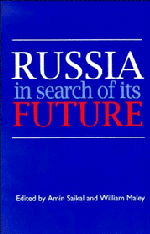2 - Russian Politics in the Time of Troubles: Some Basic Antinomies
Published online by Cambridge University Press: 03 May 2011
Summary
We shall not be able to come to a deep understanding of Russia's political situation if we concentrate only on the processes of political games or on the formal analysis of institutions. For that reason, this chapter contains three sections–historical, sociocultural and political in the proper sense. I open with a brief systematic outline of the mechanics of power and principles of functioning of the developed Soviet political regime which prevailed until the first half of the 1980s, as experience of this system forms part of the political heritage of post-Communist Russia.
Mechanics of power: modus operand! of the Soviet regime
A mass party built on the principles of strict centralism–the Communist Party of the Soviet Union–was the only organised force in official political life. This ensured political control over all levels of society and the spread and duplication of commands issued from the single centre. Mikhail Gorbachev and part of his team made serious efforts to turn this mechanism into a force that could be an instrument for positive change, but all these attempts failed. The party mechanism acted for many decades to protect conservatism, and to preserve the old state of things. It proved to be absolutely inappropriate as a means for promoting the true modernisation of the regime.
- Type
- Chapter
- Information
- Russia in Search of its Future , pp. 12 - 27Publisher: Cambridge University PressPrint publication year: 1994



